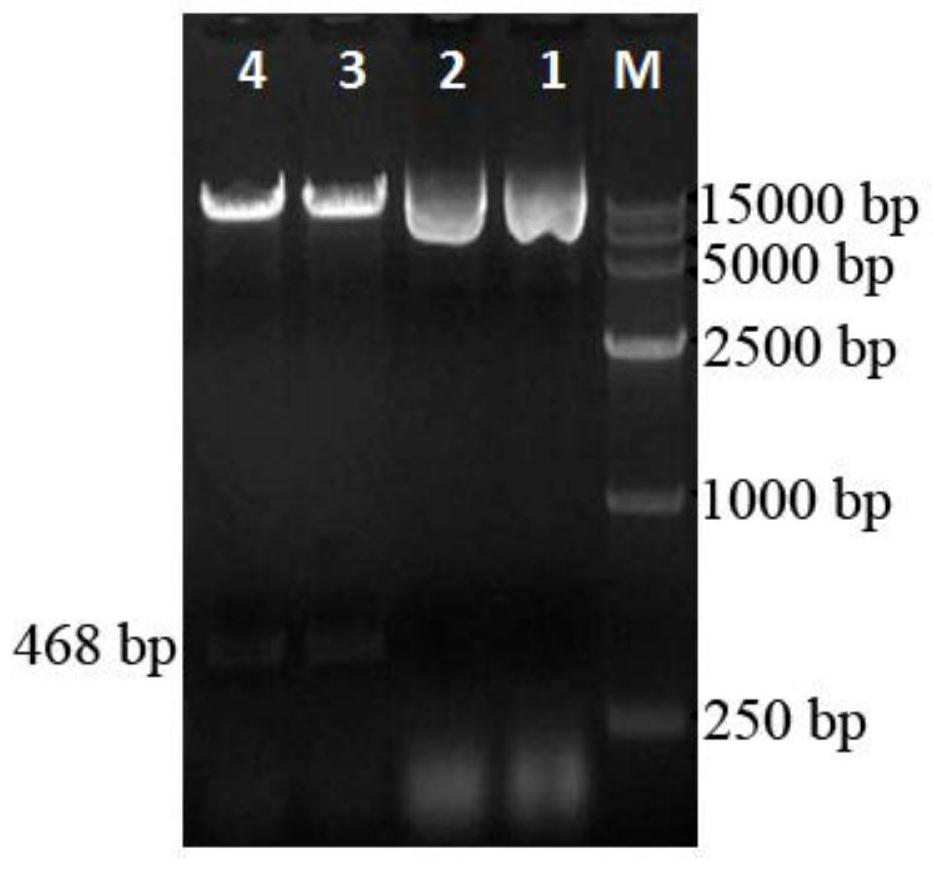Salt tolerance gene hgs3 of halophytic grass and its application
A technology of salt-tolerant gene and salt-growing grass, which is applied in the field of plant bioengineering and transgenic to achieve the effect of excellent salt-tolerant characteristics
- Summary
- Abstract
- Description
- Claims
- Application Information
AI Technical Summary
Problems solved by technology
Method used
Image
Examples
Embodiment 1
[0033] The preparation method of halophytic grass salt tolerance gene HgS3 described in embodiment 1, its main feature is that the steps are:
[0034] Using 200mM NaCl treatment of 3-7d leaf tissue of Saltwort seedlings as material, total RNA was extracted by Trizol method, the first strand of cDNA was synthesized by reverse transcription using a cDNA synthesis kit (Dalian Bao Biological Engineering Co., Ltd.), and the amplified Gene fragment, PCR reaction system: 5×PrimeSTAR Buffer 5 μL, dNTP Mixture (2.5 mM each) 2 μL, upstream primer F15’-AAAAGACACTCCATAATCTTGTGTT-3’ (10 μM) 1 μL, downstream primer R1 5’-TTTTATTGATGCAAATAAGCTACTA-3’ (10 μM) 1 μL (Synthesized by Shanghai Sangon Bioengineering Co., Ltd.), 1 μL of cDNA, 0.25 μL of PrimeSTAR HS DNA polymerase, 14.75 μL of ultrapure water, and a total volume of 25 μL; the amplification program was pre-denaturation at 94°C for 4 min, 94°C for 50 s, 60°C for 20 s, 72°C for 1min, a total of 32 cycles, 72°C for 8min, the PCR amplifi...
Embodiment 2
[0040] Embodiment 2: the preparation method of the described halophytic grass salt tolerance gene HgS3 is characterized in that the steps are:
[0041] Using 500mM NaCl treatment of 3-7d leaf tissue of Saltwort seedlings as material, total RNA was extracted by Trizol method, the first strand of cDNA was synthesized by reverse transcription using a cDNA synthesis kit (Dalian Bao Biological Engineering Co., Ltd.), and the amplified Gene fragment, PCR reaction system: 5×PrimeSTAR Buffer 5 μL, dNTP Mixture (2.5 mM each) 2 μL, upstream primer F15’-AAAAGACACTCCATAATCTTGTGTT-3’ (10 μM) 1 μL, downstream primer R1 5’-TTTTATTGATGCAAATAAGCTACTA-3’ (10 μM) 1 μL (synthesized by Shanghai Sangon Bioengineering Co., Ltd.), 1 μL of cDNA, 0.25 μL of PrimeSTAR HS DNA polymerase, 14.75 μL of ultrapure water, and a total volume of 25 μL; the amplification program was pre-denaturation at 94°C for 4 min, 94°C for 50 s, 60.4°C for 15 s, 72°C for 1min, a total of 35 cycles, 72°C for 8min, the PCR ampl...
Embodiment 3
[0042] Embodiment 3: the construction method of the expression vector of described halophytic grass salt tolerance gene HgS3, its steps are:
[0043] Two restriction sites, BamHI and SacI, were added to the upstream and downstream primers of the salt-tolerant gene HgS3 of the halophytic grass, respectively. The upstream primer F1 was 5'-CGGGATCCAAAAGACACTCCATAATCTTGTGTT-3', and the downstream primer R1 was 5'-CGAGCTCTTTTATTGATGCAAATAAGCTACTA- 3' (synthesized by Shanghai Sangon Bioengineering Co.):
[0044] Using 200mM NaCl treatment of 3-7d leaf tissue of Saltwort seedlings as material, total RNA was extracted by Trizol method, the first strand of cDNA was synthesized by reverse transcription using a cDNA synthesis kit (Dalian Bao Biological Engineering Co., Ltd.), and the amplified Gene fragment, PCR reaction system: 5×PrimeSTAR Buffer 5 μL, dNTP Mixture (2.5 mM each) 2 μL, upstream primer F1 5’-CGGGATCCAAAAGACACTCCATAATCTTGTGTT-3’ (10 μM) 1 μL, downstream primer R1 5’-CGAGCT...
PUM
 Login to View More
Login to View More Abstract
Description
Claims
Application Information
 Login to View More
Login to View More - Generate Ideas
- Intellectual Property
- Life Sciences
- Materials
- Tech Scout
- Unparalleled Data Quality
- Higher Quality Content
- 60% Fewer Hallucinations
Browse by: Latest US Patents, China's latest patents, Technical Efficacy Thesaurus, Application Domain, Technology Topic, Popular Technical Reports.
© 2025 PatSnap. All rights reserved.Legal|Privacy policy|Modern Slavery Act Transparency Statement|Sitemap|About US| Contact US: help@patsnap.com



